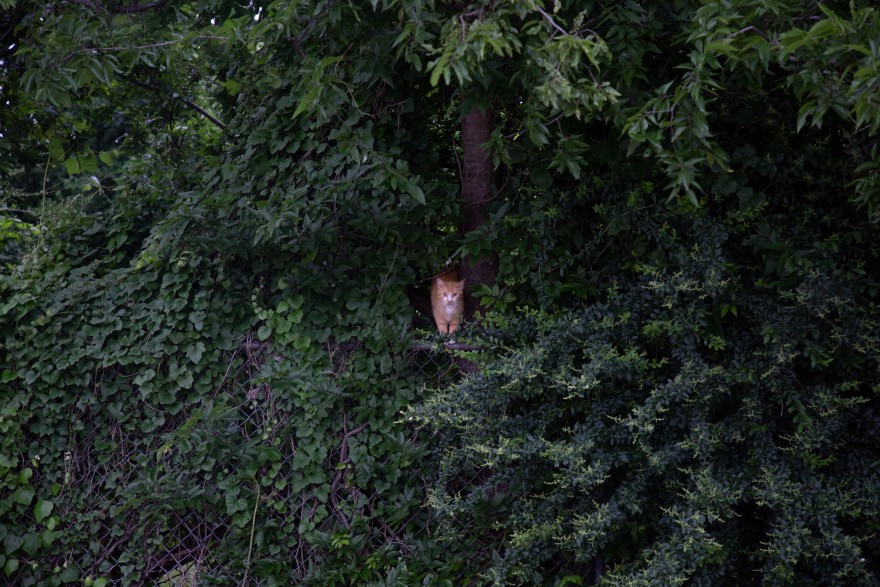From KERA:
Microwave is the king cat of UT Arlington.
Maria Luisa Cardenas, president of UTA’s Campus Cat Coalition, came by to feed him on a recent evening. He’s gray all over, with a white face and bib, and he trotted over to eat from his can with an air of supreme confidence. Cardenas called him the friendliest cat on campus.
“He’ll let anybody pet him if they bring him food. Sometimes even if you don’t have food,” Cardenas said. “He prefers food, though. That’s why he’s so fat. He’s really chonky.”
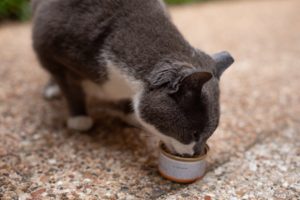
UT Arlington students provide food each day for Microwave, an iconic campus cat.
Keren Carrión
According to Cardenas, Microwave is one of more than 100 unowned cats that call UTA home. The Campus Cat Coalition cares for them, operating a feeding schedule and keeping an eye on their health. Take Microwave, for instance.
“Whenever he has something that we notice that’s bad — he’s limping, or has a bump — he’s able to be caught easily and we take him,” Cardenas said.
The Campus Cat Coalition also gets the cats spayed or neutered and vaccinated against rabies. It places friendly cats in foster homes, so they can be adopted. Earlier this year, the group even helped save a kitten from a tree.
The cat population at UTA has been growing, Cardenas said, and their lives are not easy. They face many dangers, from extreme weather to predators to cars.
My own cat, Rio, used to be a stray himself. When he entered a Humane Society of North Texas shelter, he was sick and in need of medical care.
I tried to ask Rio about his time on the streets, but he wasn’t interested in an interview. In fact, he bit my microphone — a first in my time as a reporter.
Instead, I talked to Pam Asturias, the feral cat coordinator at Feral Friends Community Cat Alliance. It’s a nonprofit that works to reduce roaming cat populations through foster, adoption and spay/neuter programs, much like the Campus Cat Coalition.
Asturias said cat populations can explode in very little time.
“I got into this 20 some-odd years ago because we fed a momma and like, four or five little babies,” she said. “Then, about two years later, we had 35 cats.”
Getting these cats sterilized is better for everyone, Asturias said.
”To keep these colonies down, for the health of the cats and then the sanity of people who care for them,” she said.
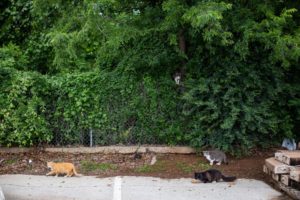
Many of the feral cats on campus slowly come crawling out to eat some of the food provided by the Campus Cat Coalition.
Keren Carrión
Feral Friends does this through a process called trap-neuter-return. Here’s how it works:
- A concerned citizen sees an unowned cat in the neighborhood.
- Feral Friends loans out a humane trap, so that person can capture the cat and bring it to a vet.
- The vet spays or neuters the cat, depending on its sex, and vaccinates it against rabies. The vet also clips the tip of one of the cat’s ears. “That’s the universal sign of a sterilized feral cat,” Asturias explained.
- Then the cat is returned to where it was found.
Asturias said there is no way to get all cats off the streets. There aren’t enough homes to go around, and some cats are too feral to live with people.
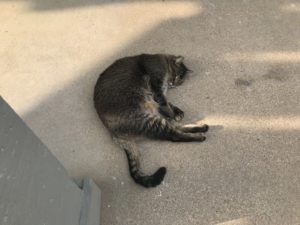
This unowned cat in Fort Worth is missing the tip of one ear. It’s the universal sign that a feral cat has been spayed or neutered.
Miranda Suarez
But there is a longstanding controversy over whether trap-neuter-return programs really work to keep cat populations down. Studies question it. Advocates point to success stories. Still others point out that good data is scarce.
A paper on the issue from Texas Parks & Wildlife, written in opposition of trap-neuter-return programs, points out that cats are a menace to wildlife. A 2013 study estimated that cats kill somewhere between one billion and four billion birds each year in the continental U.S.
A lot of the opposition to trap-neuter-release comes from bird conservation groups, like the Audubon Society.
Chuck Baskin, the president of the Fort Worth Audubon Society, said the cats in his South Arlington neighborhood treat his bird feeders like a restaurant.
“Birds are having enough trouble with expanding cities, residential areas covering up what used to be prime habitat,” he said.
Although it’s not an issue his chapter has gotten involved in locally, Baskin opposes trap-neuter-return. The alternatives?
“One is rehabbing them and trying to find homes for them, and the other is to euthanize them,” Baskin said. “You can get into all kinds of arguments there, but just don’t turn your cats loose.”
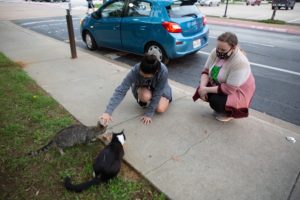
Members of the Campus Cat Coalition at UT Arlington pulled over after spotting two stray cats, and provided cans of cat food.
Keren Carrión
As you may imagine, other animal advocates say euthanizing unowned cats is wrong, and ultimately won’t do enough to control the population anyways. So the argument continues.
Baskin said one solution is for all cat owners to keep their cats inside.
One researcher has suggested equipping outdoor cats with a bird-safe collar — a big, colorful clown ruff that makes it easier for birds to spot a stalking feline.
And Pam Asturias from Feral Friends pointed out that if you don’t want cats hanging around your home, there are plenty of tips out there to deter them humanely.
“No matter if you like the cats, or you hate the cats, everybody wants less cats,” she said.
Got a tip? Email Miranda Suarez at msuarez@kera.org. You can follow Miranda on Twitter @MirandaRSuarez.


